Roden, Robert Hugh
Killed in Flying Accident 1956-08-13
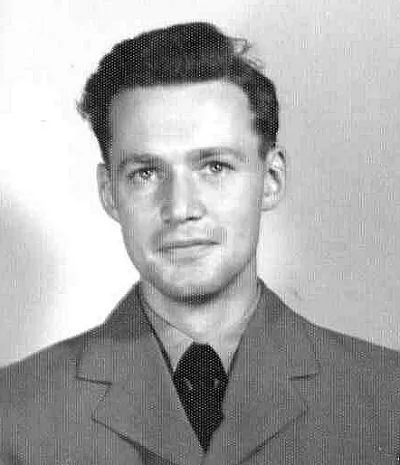

Birth Date: 1932-June-09
Born: Birmingham, England
Son of Leslie Bawtree and Irene May (nee Southerton) Roden of Birmingham, England. Brother of Norman J. Roden.
Home: Birmingham, England
Enlistment: Vancouver, British Columbia
Enlistment Date: 1954-07-09
Service
RCAF
Unit
410 Sqn- Squadron
Noctivaga Wandering by Night
Base
Rank
Flying Officer
Position
Flying Officer
Service Numbers
224933
Home
 Birmingham, England
Birmingham, England
First Burial
 Brookwood Military Cemetery, Brookwood, Surrey, Uk
Brookwood Military Cemetery, Brookwood, Surrey, Uk
North American Sabre F-86 CAC FJ-2 FJ-3 CA-27 CL-13
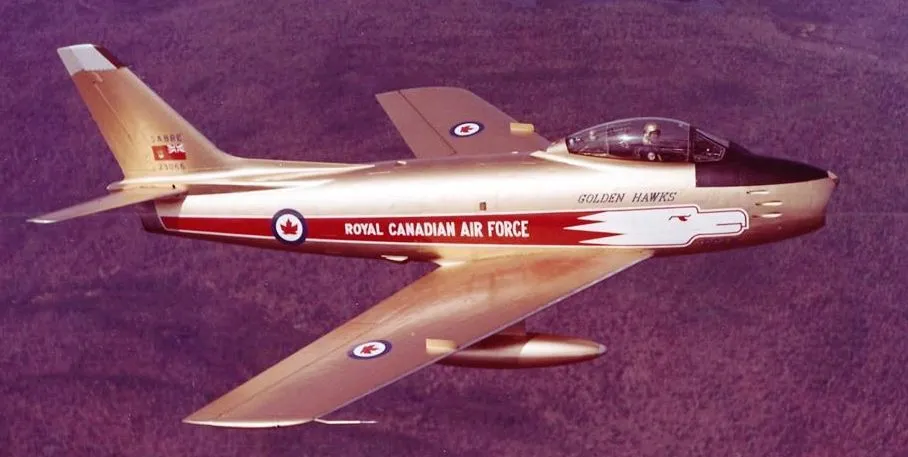
Canadair CL-13 Sabre Mk. 5 (Serial No. 23066), Golden Hawks
The North American F-86 Sabre, sometimes called the Sabrejet, is a transonic jet fighter aircraft. Produced by North American Aviation, the Sabre is best known as the United States' first swept-wing fighter that could counter the swept-wing Soviet MiG-15 in high-speed dogfights in the skies of the Korean War (1950"“1953), fighting some of the earliest jet-to-jet battles in history. Considered one of the best and most important fighter aircraft in that war, the F-86 is also rated highly in comparison with fighters of other eras. Although it was developed in the late 1940s and was outdated by the end of the 1950s, the Sabre proved versatile and adaptable and continued as a front-line fighter in numerous air forces.
Its success led to an extended production run of more than 7,800 aircraft between 1949 and 1956, in the United States, Japan, and Italy. In addition, 738 carrier-modified versions were purchased by the US Navy as FJ-2s and -3s. Variants were built in Canada and Australia. The Canadair Sabre added another 1,815 aircraft and the significantly redesigned CAC Sabre (sometimes known as the Avon Sabre or CAC CA-27), had a production run of 112. The Sabre is by far the most-produced Western jet fighter, with a total production of all variants at 9,860 units.
The fighter-bomber version (F-86H) could carry up to 2,000 lb (907 kg) of bombs, including an external fuel-type tank that could carry napalm. Unguided 2.75-inch (70-millimeter) rockets were used on some fighters on training missions, but 5-inch (127 mm) rockets were later carried on combat operations. The F-86 could also be fitted with a pair of external jettisonable jet fuel tanks (four on the F-86F beginning in 1953) that extended the range of the aircraft. Both the interceptor and fighter-bomber versions carried six 0.50 in (12.7 mm) M3 Browning machine guns with electrically-boosted feed in the nose (later versions of the F-86H carried four 20 mm (0.79 in) cannon instead of machine guns). Firing at a rate of 1,200 rounds per minute, the 0.50-inch guns were harmonized to converge at 1,000 ft (300 m) in front of the aircraft, using armor-piercing (AP) and armor-piercing incendiary (API) rounds, with one armor-piercing incendiary tracer (APIT) for every five AP or API rounds. The API rounds used during the Korean War contained magnesium, which were designed to ignite upon impact, but burned poorly above 35,000 ft (11,000 m) as oxygen levels were insufficient to sustain combustion at that height. Initial planes were fitted with the Mark 18 manual-ranging computing gun sight. The last 24 F-86A-5-Nas and F-86Es were equipped with the A-1CM gunsight-AN/APG-30 radar, which used radar to automatically compute a target's range, which later proved to be advantageous against MiG opponents over Korea.Wikipedia
 Wikipedia North American F-86 Sabre
Wikipedia North American F-86 Sabre
 YouTube F-86 Sabre Aerobatics - No Music! - Airshow London 2018
YouTube F-86 Sabre Aerobatics - No Music! - Airshow London 2018



410 Sqn Noctivaga ("Cougar")
History of the Squadron during World War II (Aircraft: Defiant IF, Beaufighter IIF, Mosquito NF II, FB VI, NF XIII,)
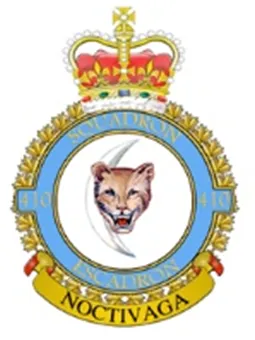
The Squadron was formed at Ayr, Scotland on June 30, 1941 as the RCAF's third Night Fighter squadron to be formed overseas in WWII. It was the ninth RCAF squadron formed overseas. The squadron flew Boulton Paul Defiant, Bristol Beaufighter and later de Havilland Mosquito aircraft in the night air defence of Britain, and then Europe. It was based at a number of locations in the UK before moving to Europe in September 1944, where it remained until the end of hostilities. It was disbanded at Gilze-Rijen, the Netherlands , on June 9, 1945.
In the course of the conflict, the squadron flew 2972 sorties and accounted for 75 enemy aircraft confirmed destroyed, with 2 probables and 9 damaged. Operational casualties were 17 aircraft and 32 aircrew, of whom 10 were killed, 20 presumed killed and 2 POW. The squadron had 10 aces (shot down 5 or more enemy aircraft), of whom 4 were pilots and the others navigators: kills were credited to both crew members (Flight Lieutenant R.D. Schultz DFC&Bar; Flying Officer D.G. Tonque, RAF DFC&Bar (Nav.); Lieutenant A.A. Harrington (USAAF) DSO,DFC; Flight Lieutenant C.E. Edinger DFC; Flying Officer J.S. Christie (RAF) DFC (Nav.); Flying Officer C.L. Vaessen DFC (Nav.); Flight Lieutenant G.P.A. Bodard DFC (Nav.); Squadron Leader J.D. Somerville DSO, DFC; Flying Officer G.D. Robinson DFC (Nav.); Flight Lieutenant V.A. Williams DFC (Nav.). The squadron won 1 DSO, 1 MBE, 2 Bars to DFC, 19 DFCs, 1 BEM and 17 Mentioned in Dispatches. Battle Honours were: Defence of Great Britain 1941-44, Fortress Europe 1943, France and Germany 1944-45 Normandy 1944, Rhine, Biscay 1943.Wikipedia, Kostenuk and Griffin
Maps for Movements of 410 Squadron 1941-45
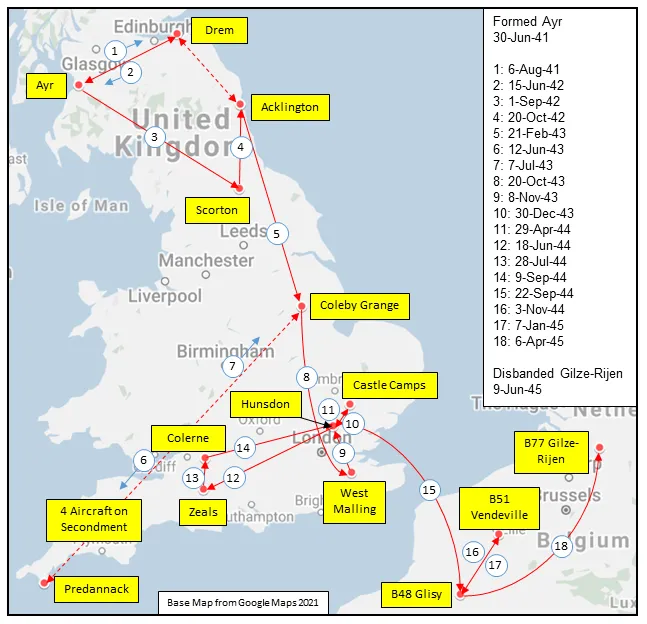
410 Squadron History Summary 1941-45
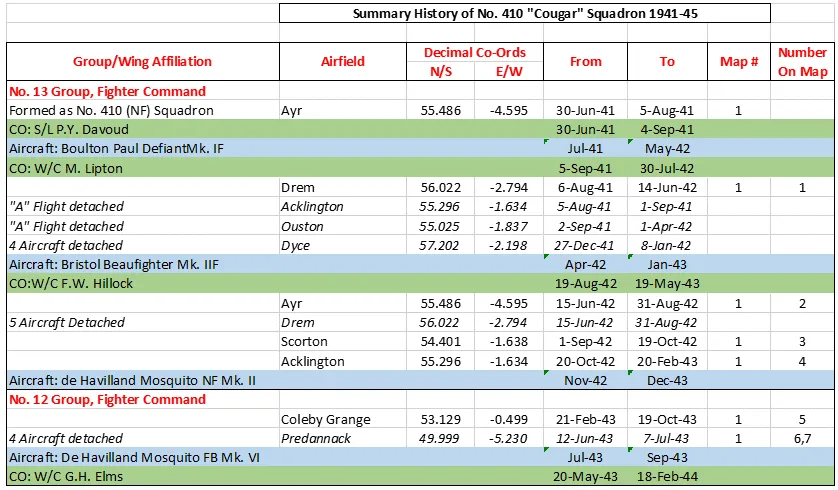
410 Squadron History Summary 1941-45 Page 2
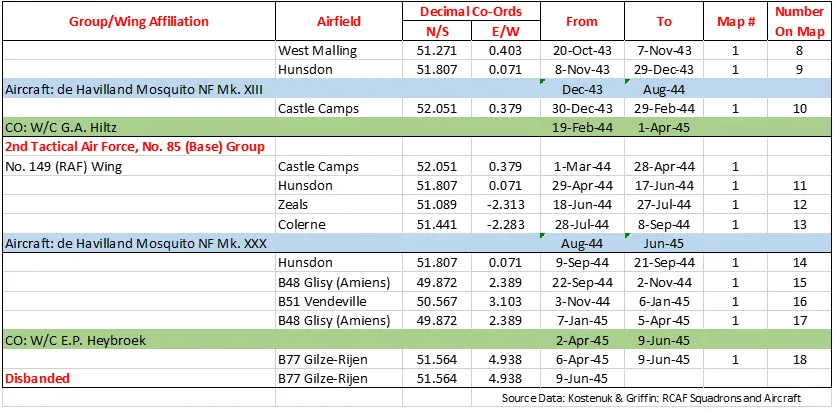
History of the Squadron Post-WWII (Aircraft: Vampire III, Sabre 2, CF-100, Voodoo, Hornet)
The squadron was re-formed in a Fighter role at St Hubert (Montreal), Quebec on 1 December 1948. It was the first post-war Regular Force fighter unit, the first to fly Vampire and Sabre aircraft, and the first to join No. 1 (Fighter) Wing of No. 1 Air Division Europe. In 1956, it was decided to replace one Sabre squadron in each of the Air Division’s four wings with an all-weather fighter unit. When No. 445 AW(F) Squadron arrived from Canada, No. 410 was deactivated at Marville, France on 1 October 1956 and reactivated as All-Weather (Fighter) at Uplands (Ottawa), Ontario on 1 November. The squadron flew CF-100 and CF-101 aircraft on North American air defence until being disbanded on 1 April 1964.
In 1968, No.3 (Operating Training Unit) at CFB Bagotville, Quebec , which was tasked with training pilots and navigators for the three operational RCAF Voodoo squadrons, was renamed No. 410 Squadron. It moved to Cold Lake, Alberta in 1982, changing aircraft to become the training unit for Canada's new CF-18 Hornet aircraft. The squadron’s mission is: To Train World Class Fighter Pilots to Meet Canada's Needs.
The squadron runs two ab initio Fighter Pilot Courses (FPC) each year, training up to 20 fighter pilots. Each course comprises seven intense months of academics, simulator flights and flying missions. Graduates are taken from 419 Tactical Fighter (Training) Squadron (also known as NATO Flying Training in Canada (NFTC) Phase IV) and then provided with the tools to develop a solid foundation in both air-to-air and air-to-ground fighter combat.The squadron is also responsible for training and recertifying approximately five former CF-18 Hornet pilots annually. These are pilots who are returning to the CF-18 cockpit after a ground or exchange tour. Furthermore, 410 Squadron also trains newly arrived foreign exchange officers who will be joining one of Canada's two operational fighter squadrons.
A lesser-known sub-unit of 410 Squadron is FOTEF. FOTEF - the Fighter Operational Test & Evaluation Flight - is responsible for the operational testing and evaluation to meet the needs of the Fighter Force (FF). Their efforts have been and continue to be integral to the operational effectiveness of all aspects of core and CF-18 capabilities. Some the new systems being evaluated are Night Vision Imaging Systems (NVIS), Multi-function Information Distribution Systems (MIDS), the Advanced Multi-role Infra-Red Sensor, the evaluation of new mission planning software and the Advanced Distributed Combat Training System (the civilian contracted simulator system). Working closely with a variety of key units across the Air Force including the Aerospace Engineering & Test Establishment (AETE), FOTEF has enabled the seamless integration of newly modernized CF-18 ECP-583 R2 aircraft into the FF.
 Canadian Virtual War Memorial
Canadian Virtual War Memorial Harold A Skaarup Web Page
Harold A Skaarup Web Page